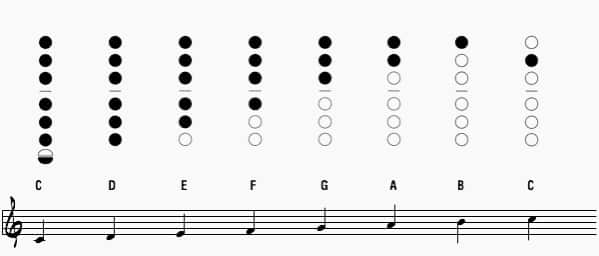The saxophone is significantly popular among music and musical instrument lovers as it can play various music genres.
From pop to classical music, you can play the saxophone to make wonderful sounds and melodies.
For learning to play the saxophone, the ultimate thing is learning how to position the mouth, fingers, and whole-body appropriately.
You need to learn the fundamental notes, including B, A, G, F, E, and D. After that, you can move to learn advanced saxophone skills.
Saxophone Overview
Saxophone learning demands tolerance and hard work. First and foremost, you need to learn how to position the mouth, fingers, and whole-body correctly.
The next thing you have to study is basic notes in saxophone charts, namely B, A, G, C, F, E, and D. Once you have done it, you can proceed to the minor and major scales.
Before you learn to play the saxophone, it is necessary to have a considerable investment in a sturdy and good-quality musical instrument.
A trustworthy method of checking a saxophone is to ensure no dent on the neck and an even surface of the lower body.
As the key matches the hands, it is good to practice holding the instrument. The key should offer comfortable feelings when you play.
With continuous exercise and patience, it is fine to play with a band when you learn to play the sax for 2-4 years.
The Guideline On How To Learn The Saxophone
You can do it by following the nine steps below:
Buy a suitable model
It is unlikely for you to produce beautiful melodies with the saxophone if the instrument is malfunctioning.
Thus, you need to pick up a suitable and good-quality saxophone. One recommended saxophone for beginners is Cecilio E-Flat Alto Saxophone.
A lot of music instructors suggest the alto saxophone by Cecilio as it is a wonderful instrument for musical beginners. The fast action keys are easy to play with their high responsiveness and comfort.
The bore also helps beginners to play all the sounds on the sax. The product has taken some examinations of quality, sturdiness, and sounds.
Another reason for the recommendation is its excellent performance. It is also an outstanding instrument for average and professional saxophonists.
Study the appropriate body movement
While learning to play the saxophone, it is also important to learn the right body movement to prevent muscle aches or hurts. The simplest posture for learning is sitting on a chair.
When sitting on a chair, your back should be straight, and your neck and shoulders should be back but relaxed. You should not tilt the head in any direction or stiffen up the two shoulders.
You also should not raise your shoulders and sit too deep in the chair. Your feet should stand firmly on the floor.
Hold it correctly

Next, you put the saxophone’s strap over your head and one shoulder. You can hold the saxophone and let it relax on the right side with the lap.
Then, tighten the neck strap until it is tight and stiff so that the neck and body feel comfortable.
Put the fingers and thumbs properly
You need proper positions of the fingers on the saxophone:
- The thumb of the right hand should stay on the thumb rest.
- Making a letter “C” with both hands will help you correctly and firmly hold the instrument. You can do it by positioning four fingers together and bend the thumb of the two hands.
- You wrap both hands around the saxophone, rest them on the six keys.

Set up the saxophone’s mouthpiece
You put the mouthpiece of the saxophone to your mouth as long as it stays comfortably. If not, you need to readjust the neck strap.
The tip of the mouthpiece should rest against the bottom lip. The mouth wraps around it, producing an airtight seal with the lips.
The upper teeth should reach the peak but should not bite too hard the mouthpiece. Instead, let the teeth relax.
It is the correct mouth posture to play the saxophone, which is dubbed as an "embouchure".
Exercise blowing the saxophone
There is a need to practice blowing the sax when you don’t press any keys. The sound should be strong without abruption. If the sound is too small, you need to adjust the mouthpiece position and cover it tightly.
Blow continuously and find your mouth’s correct position until you can produce clear and strong sounds.
Begin with basic notes

To learn saxophone, you need to understand several basic notes. You can play notes of B, A, G with the fingers of the left hand and notes of F, E, D with the fingers of the right hand.
You can watch the video to start with the first five notes of the saxophone for beginners.
Study advanced skills
After practicing basic notes, you can move to advanced saxophone skills as learning scales.
You should know that it is important to understand and practice scales because they will provide a solid foundation when you proceed to play any other musical works.
The scale will give benefits of:
- Getting knowledge of harmony and the chord in musical works.
- Playing faster as you will learn the finger patterns. You will repeat the process many times.
Saxophone scales include major and minor scales. You can watch the video below to learn how to play major scales.
Practice a song
Once you have learned all the basic lessons, you can now learn how to play a song that you like.
A wide range of finger charts online is available to help if you do not know the way of reading notes.
Above is the list of guidelines for learning the saxophone. Now it’s time to move to several tips to help you learn it in a shorter time.
Plus Tips For Faster Learning
How to learn saxophone by yourself more quickly? You can do it by applying the following tips:

Be optimistic
Optimism would be a great help in shortening the learning time. It is because your mind is more responsive when you are positive.
You are likely to admit mistakes optimistically and keep learning rather than pushing yourself into errors.
Make sure that your instrument works well
You can learn in a shorter time if the instrument is reliable and works well. Otherwise, it would take much time to find the correct keys and the mouthpiece.
A malfunctioning saxophone will pull your learning progress backward. You should purchase the saxophone with good brands in the musical industry.
Set up specific and clear goals
You can get something faster when you establish short-term and long-term targets. A goal would encourage you to try harder and more energetically. It would also help you control the pace of the progress.
If you do not set a goal, you may move around aimlessly for a couple of days that cannot succeed in anything.
But a specific and achievable goal will make your learning process continuous and effective. Thus, you must rigorously and exactly follow the planned goals.
Practice every day
The minimum time for you to practice a day is from half to an hour. Keep in mind that playing the sax is the same as riding a bike.
For that, you need to practice it every day to achieve the skill. With this progress, you can play the saxophone well in 2-4 years.
If you want to learn more quickly, you need to study for more than one hour each day. Don’t forget to comply with the intended procedure during practice. “Practice makes perfect '' just works if people do everything properly.
Study the Alto Saxophone for beginning
Many musical instructors suggest the alto saxophone to beginners as it is easier to blow and easier to hold, making it a better choice than the tenor saxophone.
While some professionals claim that both are similar, the alto sax is more suitable. Though, the tenor is still good.
Take advantage of online apps
A variety of free and even paid online apps are available to motivate your progress. Google Play has incredible free online saxophone lessons that you can set up on your smartphone.
You can also arrive at the aforementioned websites and employ their helpful saxophone tutorials.
Final Words
The saxophone is a well-known musical instrument that many people find to learn playing music. Of course, you can do it by yourself with the detailed guidelines above.
The initial lesson is to learn the right posture of the mouth, fingers, and whole body for comfort. Next, you will need to study the saxophone basic notes and the saxophone scales to produce clear and continuous sounds.
The ultimate tip is to be resilient and diligent because you cannot learn in just a couple of days or weeks. Enjoy it as a funny and adventurous journey.
Good luck and success!
Related Posts:

